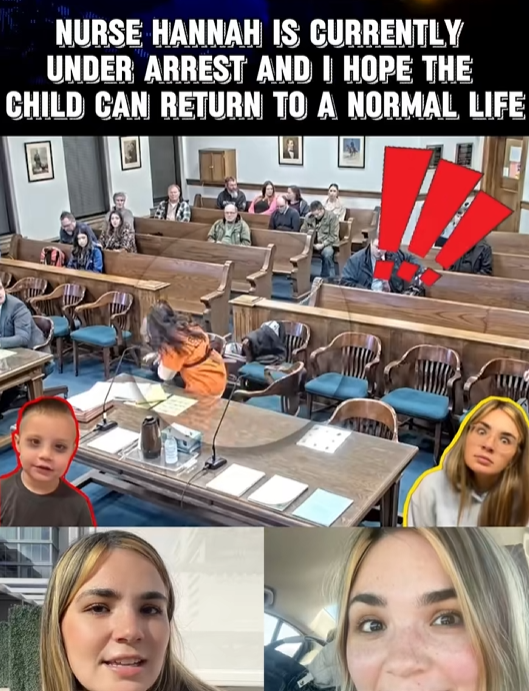What started as a lighthearted attempt to go viral on TikTok has turned into a national conversation about parenting, trauma, and what we accidentally reveal when we share too much online.
Hannah, a registered nurse and mother of a toddler, has come under fire after videos she posted to her TikTok account began circulating widely — not because of what she intended to showcase, but because of what viewers noticed in the background.
In the now-viral clips, Hannah can be seen dancing, lip-syncing, and participating in popular TikTok trends, often with her young son nearby. But it wasn’t the choreography or the hashtags that caught people’s attention. It was the child’s reactions.
Flinching. Freezing. Watching his mother’s movements with wide, alarmed eyes. In one video, as Hannah moves her hand quickly to brush her hair back, her son visibly recoils.
To some, these were red flags too loud to ignore.
“That’s Not Normal”
Psychologists, parenting advocates, and millions of everyday users began weighing in on what they were seeing.
“That’s not how a toddler should react to their parent,” one viral comment read. “He looks scared every time she moves.”
Others began stitching the videos with their own, demonstrating how their children reacted calmly — even joyfully — when they reached toward them or moved suddenly. Thus, a trend was born: #NoFlinchChallenge — where parents reached for their kids to “prove” that a child’s natural response should be trust, not fear.
Within days, the hashtag had tens of millions of views.
“I didn’t even know this was a thing until I saw her video,” one mom said in her post. “But now that I do, I’m horrified.”
While some defended Hannah, saying the internet was jumping to conclusions based on brief, decontextualized clips, others argued that even a short moment can reveal deeper patterns — especially when it comes to children who haven’t yet learned to hide how they feel.
A Closer Look at Hannah
Hannah, who has not publicly commented since the backlash began, was previously well-liked on TikTok for her relatable “nurse life” content and “honest mom” takes. But as scrutiny intensified, internet sleuths dug deeper, unearthing past videos where her tone toward her son was described as “harsh” and “cold.”
Some users pointed out moments where she appeared to mock or ignore his emotional needs on camera — treating tantrums or tears as content instead of connection.
“She weaponized motherhood for likes,” one user posted. “And now we’re seeing the cost.”
It’s unclear whether any formal investigations have been launched, but several child welfare advocacy groups have since released statements urging parents to be mindful of how their children appear online — and what those appearances might say about their environment.
Trauma in Plain Sight?
Experts warn that children exposed to volatile, neglectful, or emotionally unstable environments often develop heightened sensitivity to movement and tone. In other words: they flinch.
“When a child consistently recoils from a caregiver’s gestures, it raises serious concern,” said one child psychologist. “Children aren’t born scared of their parents. They learn that fear through repeated experiences of unpredictability, aggression, or emotional coldness.”
She adds that trauma responses don’t always come from overt abuse — they can also stem from chronic emotional neglect, harsh discipline, or exposure to yelling and instability.
And in an era where social media blurs the lines between private and public life, many worry that children are becoming unwilling participants in their parents’ content — sometimes at the cost of their safety and well-being.
The Bigger Conversation
The controversy around Hannah has since sparked broader discussions about parenting on social media: Should children be part of online content at all? When does “sharenting” cross the line? And how many warning signs do we miss while focusing on filters and follower counts?
Even creators who once regularly featured their kids are now reconsidering.
“I saw that video and immediately thought about how my toddler looks at me,” one influencer wrote. “If he ever flinched like that, I’d stop everything.”
Some users have taken the trend in a more activist direction, encouraging followers to use #NoFlinch not as a way to brag about parenting, but as a reminder of what safe, loving caregiving should look like — and to advocate for kids who can’t speak for themselves.
Where Is Hannah Now?
As of this writing, Hannah’s TikTok account has been made private or deleted entirely. She has not responded to requests for comment. It’s unclear whether she is facing any repercussions offline, professionally or personally.
Her silence, however, has not slowed the movement her videos unintentionally sparked.
For many, this was never just about Hannah. It was about the thousands — maybe millions — of children who flinch and freeze every day, not on camera, but in homes where the world isn’t watching.
And now, thanks to a viral moment that said more than it showed, people are watching more closely than ever.

